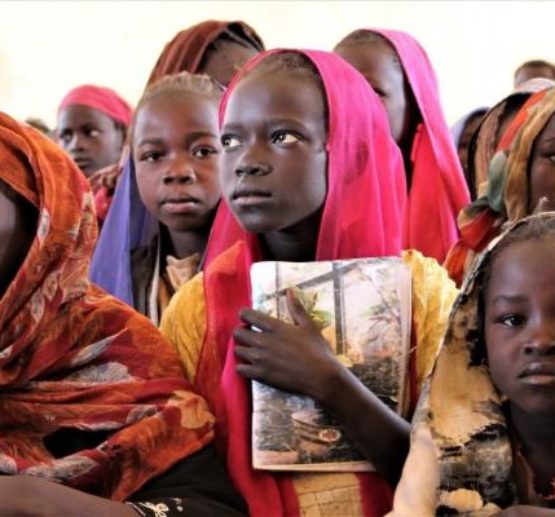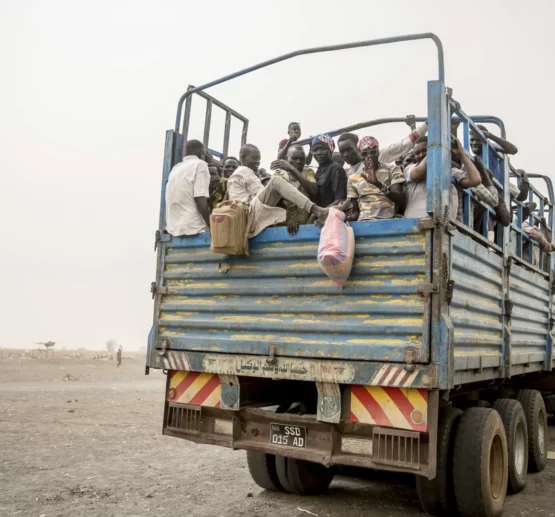Sudanese Government’s “Ceasefire” is Fundamentally Meaningless
Sudan Tribune reported last week that Sudanese President Al-Bashir has extended the government’s “unilateral ceasefire,” covering the Darfur region and various other areas of Sudan. This would be important news, if there was even a grain of truth to it.
This “ceasefire” was declared in 2016, and has had no discernible impact on actual government military behavior as government forces continue to carry out attacks against civilians. This year alone, uniformed government forces – including RSF – fought pitched battles with Rebel groups on 55 occasions.[1] The bulk of these attacks occurred in the Jebel Marra region at the center of Darfur, long a rebel-controlled area, during a government campaign to penetrate the region and root out rebel positions. This offensive has destroyed civilian villages, killed women and children, and led to the displacement of between thirty and fifty thousand people.[2] A frequent phrase in Radio Dabanga reports throughout the past several months has been “government forces shelled ___ village.” Despite the positive press image as portrayed by Khartoum, the regime continues to launch offensive military campaigns against the indigenous groups in Darfur.
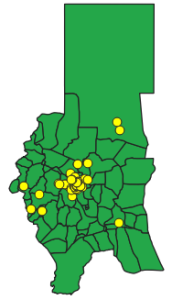
Map: Battles between Government and Rebel Forces in 2018
The ceasefire, called “unilateral” throughout the media despite depending on an agreement between multiple parties, is only between the government of Sudan and several rebel groups. These include the Justice and Equality Movement (JEM), Sudan Liberation Movement- Minni Minnawi (SLM-MM) and SLM- Transitional Council (SLM-TC), the last of which is defunct and currently controls neither military forces nor territory. The Government of Sudan therefore does not have an agreement with the remaining SLM-AW, led by Abdel-Wahid al-Nur. The fact that only a single rebel group remains fighting against the government does not mean a decrease in violence. In fact, there have been 190% more recorded firefights between government and rebel forces in the first seven months of this year compared to the total number of attacks in the entirety of 2017. It must be made clear where lies the responsibility for this escalation of violence: government policy. Rebel groups have made no attempt to break out from their base in Jebel Marra. Rather, government forces converged on the region in spring of this year, and renewed their assault on rebel positions, firing rockets and artillery indiscriminately into villages.
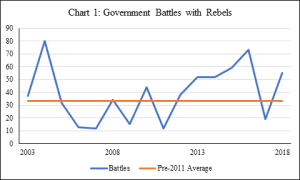
Not only do government forces continue to assault rebel positions, they also continue to perpetrate mass violence against the civilians of Darfur, again despite government claims to the international community about a “ceasefire.” Independent observers recorded 68 incidents of violence against civilians perpetrated by uniformed government forces so far in 2018.[3] Like the fighting between government and rebel forces, government attacks on civilians increased dramatically in 2011 following a renewed government offensive in Darfur, which is still ongoing. The level of violence against civilians in Darfur in 2018 is again above the average level during the pre-2011 period. This fact is fundamentally inconsistent with the notion that peace has been achieved in Darfur, and fundamentally inconsistent with the notion that a “ceasefire” has really been placed into effect. Certain weak rebel groups may have temporarily stopped fighting, but that does not mean government firing has ceased in Darfur.
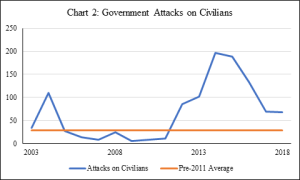
All of the above analysis demonstrates that the current level of fighting in Darfur today is actually historically high. The government launched a major offensive in Darfur in 2011, and violence continues at a level above the average before this offensive. What we see is clear indication of an ongoing, indeed escalating, government offensive in Darfur. This is not a ceasefire.
Because the wording of United States Executive Order 13067[4] specifically mentions a decline in “offensive military activity” on the part of the government of Sudan, because this then became a key metric of the “Five Track”[5] approach of the United States towards Sudan, and to create talking points for supporters of the Khartoum regime throughout the international community, it is important for Bashir to publicly commit to peace. It is desperately important to understand that this lip service has absolutely no substance. Bashir is not committed to peace, and any “ceasefire” proclaimed by the government is meaningless until the government actually decides to cease firing their weapons, especially when these weapons are often directed against civilians.
The United States is obligated by its own five-track policy to undertake practical step to assess the situation on the ground in Darfur. The United States cannot take the rhetoric of Khartoum at face value, nor can it be allowed to promote its own rhetoric of sustained peace in Darfur without any verification, especially when the facts on the ground so clearly indicate that peace has not been achieved. The Government of Sudan is desperate for international engagement and normalization of relations with the United States. They must not be allowed to achieve these goals without actually committing to peace in Darfur.
Peace in Darfur will not be achieved through rhetorical declarations, but rather through realistic measures to monitor and ensure it. DWAG believes that only the disarmament of the government’s notorious Rapid Support Forces and other Janjaweed militias, realistic accountability for the crimes committed by government officials, and a genuine peace process can put an end to the crises in Darfur.
[1] ACLED
[2] Radio Dabanga reports 50,000. The Prosecutor for the International Criminal Court reported 30,000 in her appearance before the UN Security Council in June.
[3] ACLED
[4] Signed by President Obama in January of 2016, this order began the process by which President Trump removed economic sanctions against Sudan in November of 2017.
